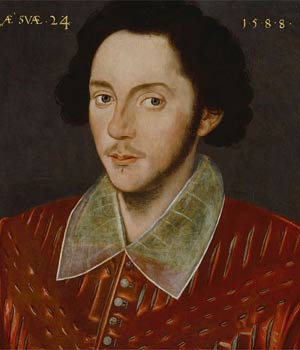 |
| Costume design for The Dark Lady of the Sonnets (1910) by Charles Ricketts Harley Granville-Barker as William Shakespeare with Red Elizabethan Lady |
"I have had great difficulty in containing myself or making myself go off to sleep the last few days, for on Thursday [2 March 1972]..... I found that I had identified the Dark Lady of Shakespeare's sonnets".
Thus A.L. Rowse in his diary entry for 5 March 1972. And there was more...
"...it is difficult to keep such a secret - I feel ready to burst. ...the only way to hold on is to tease my enemies, who have made me suffer so much anguish, and now get some fun out of it, and them".
The 'enemies' that had caused so much 'anguish' were other academics, among them renowned Shakespeare scholar Samuel Schoenbaum.
In 1964, when Rouse had asserted that the 'young man' of the sonnets was Shakespeare's patron, the Earl of Southampton, it was Professor Schoenbaum who pointed out that this claim had been made as early as 1817 by Nathan Drake.
And Rowse's pronouncement that the 'rival poet' of the sonnets was Christopher Marlowe, had fallen on deaf ears.
But now the tables had been turned. He had unravelled the secret of English literature's greatest conundrum -
"and it is right for all I have had to put up with, that it should have fallen to me to solve it".
 |
| Contemporary image used by Rowse on the title page of his book on the Dark Lady |
Rowse based his conclusion on his reading of the casebooks of the astrologer Simon Forman, on whom he was preparing a biography. From these he discovered that Emilia had been 'somewhat brown in youth', which corresponds nicely with 'dark' lady; and that her husband was called William, which neatly fits Sonnet 135:
So thou, being rich in Will, add to thy Will
One will of mine, to make thy large Will more.
Let no unkind nor fair beseechers kill;
Think all but one, and me in that one Will.
The evidence seemed impressive, until it was pointed out that Emilia's husband was not named William at all, but Alfonso. And that 'somewhat brown in youth' had been a mis-reading of 'somewhat brave in youth'.
As Professor Schoenbaum unkindly commented:
"It is useful for a Dark Lady to be demonstrably dark". [William Shakespeare - A Compact Documentary Life].
Nevertheless, Rowse's book Shakespeare's Sonnets: The Problem Solved*, became a bestseller among Shakespeare enthusiasts avid for the tiniest piece of new information on the life of their hero.
*Compare the title with Patricia Cornwell's Jack the Ripper - Case Closed, in which the popular novelist claimed to have solved a mystery which had eluded police and criminologists for over a century.
The historian Michael Wood also unequivocally endorsed Rowse in his television series In Search of Shakespeare.
Needless to say, however, there is a long list of alternative candidates for the post of the elusive Dark Lady, including the poet's wife, Anne Hathaway, Queen Elizabeth I, and, most recently, Lucy Negro, widely reported in the media. (1) So maybe the true identity will never been known.
Unless.....
Patricia Cornwell, where are you?



No comments:
Post a Comment